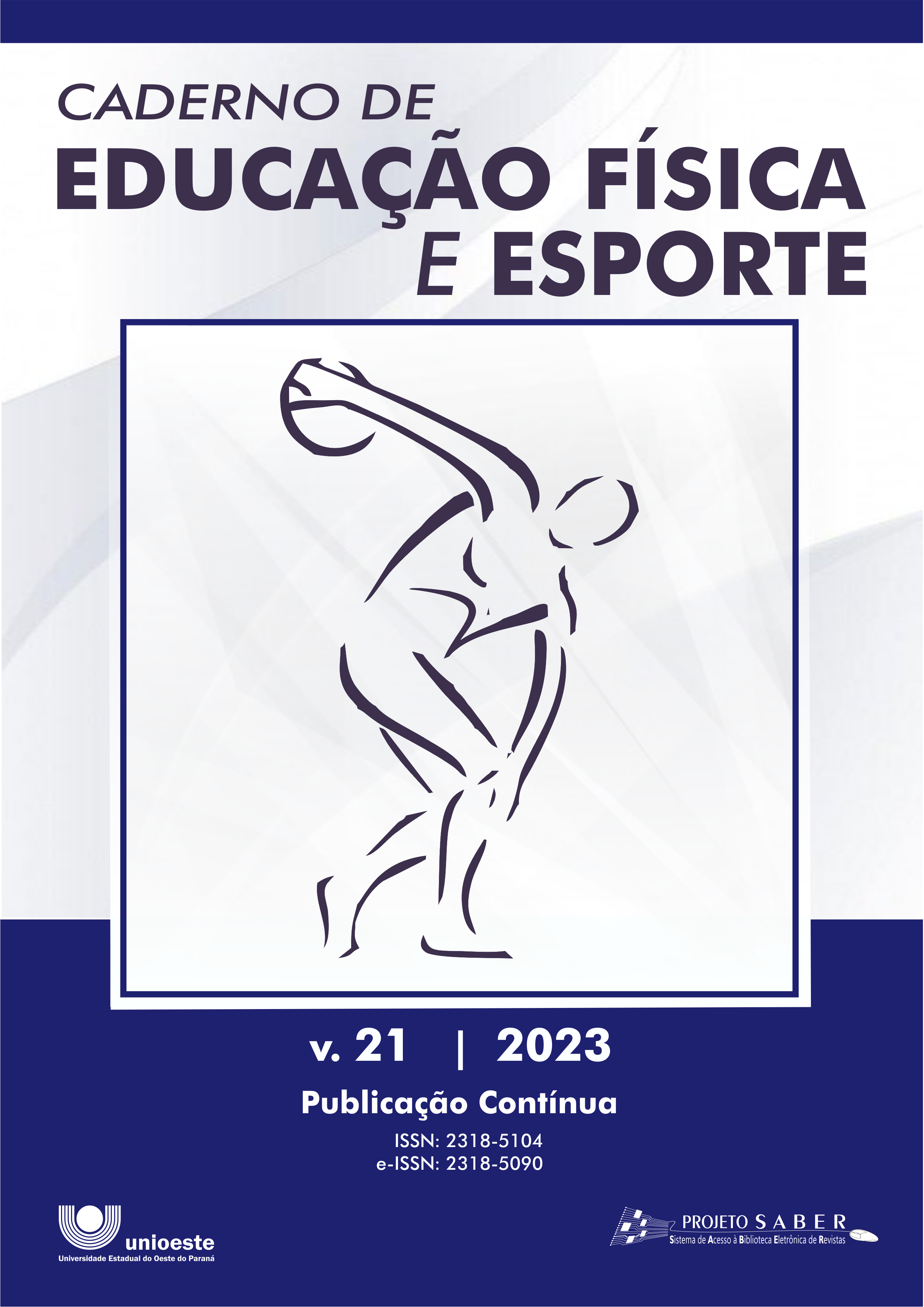Comparison of the incidence of injury and pain in CrossFit® practitioners and weight training practitioners
DOI:
https://doi.org/10.36453/cefe.2023.31278Keywords:
Incidence, Injuries, Pain, Physical ExerciseAbstract
BACKGROUND: Nowadays, even with the high demand for activities such as CrossFit®, traditional weight training (WT) is still the most popular method for individuals of all age groups. Although it is an activity with a potential risk of pain and injury, when not properly guided and executed, some professionals believe it to be less harmful or aggressive when compared to CrossFit®, due to the lower impact exercises.
OBJECTIVE: The aim of this study was to compare the incidence of injuries and pain between individuals practicing CrossFit® and those practicing WT.
METHODS: For this cross-sectional study, an interview was performed via an online platform, in which 96 individuals who practiced WT and 99 individuals who practiced CrossFit® were evaluated on the modality practiced and history of pain and injuries. Student’s t-test for independent samples was used to investigate a possible difference in incidence rates between the groups.
RESULTS: No statistically significant difference (p>0.05) was found regarding the presence and/or number of injuries between CrossFit® practitioners and WT practitioners. There was also no difference (p>0.05) between the groups regarding the onset of pain after starting to practice and its intensity, as well as its return, interruption, or reduction.
CONCLUSION: This study showed that both individuals practicing CrossFit® and individuals practicing WT have similar injury and pain conditions. Thus, although CrossFit® is considered a high-impact activity practiced at high intensities, it can be practiced safely, provided it is properly monitored.
Downloads
References
BELLAR, D.; HATCHETT, A.; JUDGE, L. W.; BREAUX, M. E.; MARCUS, L. The relationship of aerobic capacity, anaerobic peak power and experience to performance in Crossfit exercise. Biology of Sport, v. 32, n. 4, p. 315-20, 2015. Disponível em: https://pubmed.ncbi.nlm.nih.gov/26681834/
CLAUDINO, J. G.; GABBETT, T. J.; BOURGEOIS, F.; SOUZA, H. S.; MIRANDA, R. C.; MEZÊNCIO, B.; ... ; SERRÃO, J. C. CrossFit overview: Systematic review and meta-analysis. Sports Medicine Open, v. 4, n. 1, p. 1-11, 2018. DOI: https://doi.org/10.1186/s40798-018-0124-5
COSTA, T. S.; LOUZADA, C. T. N.; MIYASHITA, G. K.; SILVA, P. H. J.; SUNGAILA, H. Y. F.; LARA, P. H. S.; ... ; ARLIANI, G. G. CrossFit: Injury prevalence and main risk factors. Clinics, v. 74, p. 1-5, 2019. DOI: https://doi.org/10.6061/clinics/2019/e1402
FOSCHINI, D.; PRESTES, J.; CHARRO, M. A. Relação entre exercício físico, dano muscular e dor muscular de início tardio. Revista Brasileira de Cineantropometria e Desempenho Humano, v. 9, n. 1, p. 101-6, 2007. Disponível em: https://periodicos.ufsc.br/index.php/rbcdh/article/view/4038
HALL, F. C.; NOONAM R. J. A qualitative study of how and why gym-based resistance training may benefit women’s mental health and wellbeing. Performance Enhancement & Health, v. 11, n. 3, e100254, 2023. DOI: https://doi.org/10.1016/j.peh.2023.100254
KETTUNEN, J. A.; KUJALA, U. M.; KAPRIO, J.; KOSKENVUO, M.; SARNA, S. Lower limb function among former elite male athletes. The American Journal of Sports Medicine, v. 27, n. 1, p. 133-40, 2001. DOI: https://doi.org/10.1177/0363546501029001080
KLIMEK, C.; ASHBECK C.; BROOK, A. J.; DURALL, C. Are injuries more common with Crossfit training than other forms of exercise. Journal of Sport Rehabilitation, v. 27, n. 3, p. 295-9, 2018. DOI: https://doi.org/10.1123/jsr.2016-0040
LEMOS, E. C. W. M.; GUADAGNIN, E. C.; MOTA, C. B. Influence of strength training and multicomponent training on the functionality of older adults: systematic review and meta-analysis. Revista Brasileira de Cineantropometria & Desempenho Humano, v. 22, e60707, 2020. DOI: https://doi.org/10.1590/1980-0037.2020v22e6070
LOPES, P.; BEZERRA, F. H. G.; NADSON FILHO, A.; BRASILEIRO, I.; PACHECO NETO, P.; SANTOS JÚNIOR, F. Lesões osteomiarticulares entre os praticantes de CrossFit. Motricidade, v. 14, n. 1, p. 266-70, 2018. Disponível em: https://www.proquest.com/openview/2388d9c95a64008548fab8832f92aacb/1?pq-origsite=gscholar&cbl=616555
MONTALVO, A. M.; SHAEFER, H.; RODRIGUEZ, B.; LI, T.; EPNERE, K.; MYER, G. D. Retrospective injury epidemiology and risk factors for injury in CrossFit. Journal of Sports Science and Medicine, v. 16, n. 1, p. 53-59, 2017. Disponível em: https://www.ncbi.nlm.nih.gov/pmc/articles/PMC5358031/
OLIVA, O. J.; BANKOFF, A. D. P.; ZAMAI, C. A. Possíveis lesões musculares e ou articulares causadas por sobrecarga na prática da musculação. Revista Brasileira de Atividade Física e Saúde, v. 3, n. 3, p. 15-23, 2012. DOI: https://doi.org/10.12820/rbafs.v.3n3p15-23
PEREIRA, L. C.; PINTO, J. C. B. L.; FIRMEZA, D. D.; HONORATO, R. C.; MEDEIROS, R. M. V.; DANIELE, T. M. C.; FONTELES, A. I. Uma semana de Crossfit não modifica carga interna, sintomas de estresse e dor muscular. Revista Brasileira de Prescrição e Fisiologia do Exercício, v. 13, n. 84. p. 547-53, 2019. Disponível em: http://www.rbpfex.com.br/index.php/rbpfex/article/view/1729
PORTNEY, L. G.; WATKINS M. P. Foundations of clinical research: Applications to practice. 3. ed. Upper Saddle River: Pearson Prentice Hall, 2009.
RUEGSEGGER, G. N.; BOOTH, F. W. Health benefits of exercise. Cold Spring Harbor Perspectives in Medicine, v. 8, n. 7, a029694, 2018. DOI: https://doi.org/10.1101/cshperspect.a029694
SOUZA, E. B.; CUNHA, F. M. A. M. Incidência de lesões desportivas advindas da prática do treinamento resistido: uma revisão integrativa. Lecturas: Educación Física y Deportes, n. 214, 2016. Disponível em: https://www.efdeportes.com/efd214/lesoes-advindas-do-treinamento-resistido.htm
SPREY, J. W.; FERREIRA, T.; DE LIMA, M. V.; DUARTE, A. J.; JORGE, P. B.; SANTILI, C. An epidemiological profile of Crossfit athletes in Brazil. Orthopaedic Journal of Sports Medicine, v. 4, n. 8, e2325967116663706, 2016. DOI: https://doi.org/10.1177/2325967116663706
WEISENTHAL, B. M.; BECK, C. A.; MALONEY, M. D.; DEHAVEN, K. E.; GIORDANO, B. D. Injury rate and patterns among Crossfit athletes. Orthopaedic Journal of Sports Medicine, v. 2, n. 4, p. 2325967114531177, 2014. DOI: https://doi.org/10.1177/2325967114531177
Downloads
Published
How to Cite
Issue
Section
License
Copyright (c) 2023 Direitos Autorais Partilhados

This work is licensed under a Creative Commons Attribution-NonCommercial-ShareAlike 4.0 International License.
Os direitos autorais permitem descarregar, compartilhar, copiar, distribuir, adaptar, transformar, exibir, reproduzir a totalidade ou partes do artigo para qualquer propósito legal, desde que não tenha fins lucrativos e seja citada a fonte.
Informamos que todo o conteúdo do texto publicado, e dos seus possíveis erros ortográficos e gramaticais, é de inteira responsabilidade de seus autores, não cabendo ao Caderno de Educação Física e Esporte, ou aos nossos Avaliadores Ad Hoc, por qualquer implicação legal ou por eventual negligência à língua portuguesa ou à estrangeira.



















